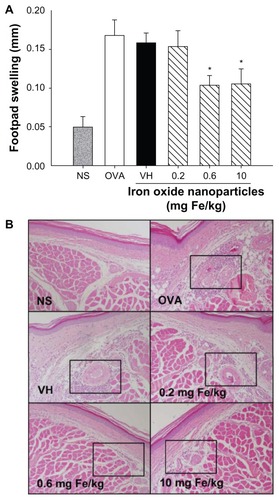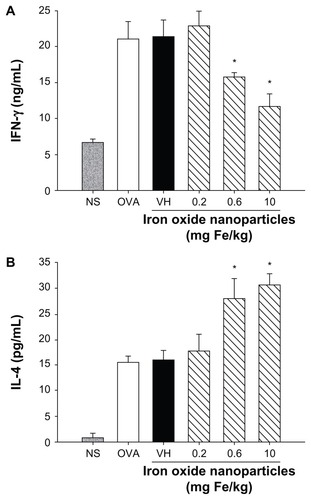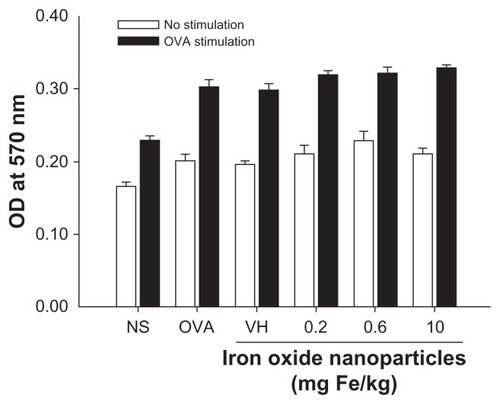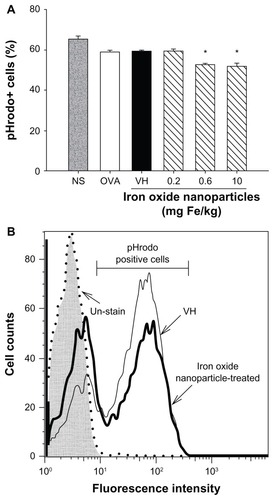Figures & data
Figure 1 Protocol of iron oxide nanoparticle administration and ovalbumin sensitization and challenge. BALB/c mice were randomly divided into the following groups (five mice per group): (1) nonsensitized (but ovalbumin-challenged) group; (2) untreated ovalbumin-sensitized and challenged group; (3) vehicle-treated (saline 0.2 mL/mouse) plus ovalbumin-sensitized and challenged group; and (4) iron oxide nanoparticle-treated (0.2–10 mg iron/kg, 0.2 mL/mouse) plus ovalbumin-sensitized and challenged group. The dosing regimen for iron oxide nanoparticle administration and antigen sensitization and challenge are described in the materials and methods.
Abbreviation: OVA, ovalbumin.

Table 1 Immunohistochemical staining of CD3+, F4/80+, Foxp3, interferon-γ, interleukin-6, and tumor necrosis factor-α+ cells in the footpads of ovalbumin-sensitized and challenged mice
Figure 2 Inhibition by iron oxide nanoparticle administration of the footpad swelling and inflammatory cell infiltration associated with delayed-type hypersensitivity. BALB/c mice were treated as the protocol depicted in . Delayed-type hypersensitivity reactions in the footpad were induced by a subcutaneous ovalbumin challenge. (A) The thickness of footpads was measured before and 24 hours after the ovalbumin challenge. (B) The tissue sections were stained with hematoxylin and eosin (original magnification, ×200). Boxes show subcutaneous regions with heavy infiltration of mononuclear cells in the untreated ovalbumin-sensitized group and vehicle-treated group, which appears to be diminished in the iron oxide nanoparticle-treated (0.6 and 10 mg/kg) groups.
Notes: The data are expressed as the mean ± standard error of six to eight samples per group. *P < 0.05 compared to the vehicle-treated group. Results are representative of three independent experiments.
Abbreviations: Fe, iron; NS, nonsensitized group; OVA, untreated ovalbumin-sensitized and challenged group; VH, vehicle-treated plus ovalbumin-sensitized and challenged group.

Figure 3 Iron oxide nanoparticles inhibited the expression of interferon-γ and tumor necrosis factor-α in footpads. (A) Representative light micrograph of interferon-γ-stained footpad sections is shown (original magnification, ×200). The box shows subcutaneous regions with interferon-γ signals in the untreated ovalbumin-sensitized group. Representative light micrographs of (B) interferon-γ-stained and (C) tumor necrosis factor-α-stained footpad sections are shown (original magnification, ×400).
Notes: Arrows indicate positive cells. Quantified data are presented in .
Abbreviations: Fe, iron; NS, nonsensitized group; OVA, untreated ovalbumin-sensitized and challenged group; VH, vehicle-treated plus ovalbumin-sensitized and challenged group.

Figure 4 Differential effects of iron oxide nanoparticles on the production of antigen-specific interferon-γ and interleukin-4 by splenocytes. Splenocytes isolated from each group of mice were cultured in the presence of ovalbumin (50 μg/mL) for 72 hours, and the supernatants were collected for measurement of (A) interferon-γ and (B) interleukin-4 by enzyme-linked immunosorbent assay.
Note: Data are expressed as the mean ± standard error of six samples pooled from two experiments; *P < 0.05 compared to the vehicle-treated group.
Abbreviations: Fe, iron; NS, nonsensitized group; OVA, untreated ovalbumin-sensitized and challenged group; VH, vehicle-treated plus ovalbumin-sensitized and challenged group.

Figure 5 Effect of iron oxide nanoparticles on the viability of splenocytes. Splenocytes isolated from each group of mice were cultured in the presence of ovalbumin (50 μg/mL) for 72 hours. The viability of splenocytes was determined by 3-(4,5-dimethylthiazol-2-yl)-2,5-diphenyl-tetrazolium bromide assay.
Notes: Data are expressed as the mean ± standard error of quadruplicate cultures. Results are representative of three independent experiments.
Abbreviations: Fe, iron; NS, nonsensitized group; OD, optical density; OVA (key), ovalbumin; OVA (X-axis), untreated ovalbumin-sensitized and challenged group; VH, vehicle-treated plus ovalbumin-sensitized and challenged group.

Figure 6 Iron oxide nanoparticles suppressed the phagocytic activity of splenic CD11b+ cells. (A) CD11b+ cells from the spleen were isolated using anti-CD11b magnetic beads. The phagocytic activity of CD11b+ cells was measured by flow cytometry using pH-sensitive pHrodo® Escherichia coli BioParticles™ conjugate (Invitrogen Life Technologies, Carlsbad, CA) as described in the materials and methods. (B) Representative histograms of the uptake of pHrodo by splenic CD11b+ cells in vehicle-treated and iron oxide nanoparticle-treated (10 mg/kg) groups are illustrated.
Notes: Data are expressed as the mean ± standard error of triplicate samples per group; *P < 0.05 compared to the vehicle-treated group. Results are representative of three independent experiments.
Abbreviations: Fe, iron; NS, nonsensitized group; OVA, untreated ovalbumin-sensitized and challenged group; VH, vehicle-treated plus ovalbumin-sensitized and challenged group.
